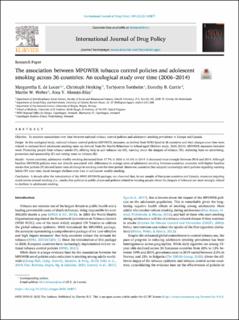| dc.contributor.author | de Looze, Margaretha E. | |
| dc.contributor.author | Henking, Christoph | |
| dc.contributor.author | Torsheim, Torbjørn | |
| dc.contributor.author | Currie, Dorothy B. | |
| dc.contributor.author | Weber, Martin W. | |
| dc.contributor.author | Alemán-Díaz, Aixa Y. | |
| dc.date.accessioned | 2023-02-16T13:32:38Z | |
| dc.date.available | 2023-02-16T13:32:38Z | |
| dc.date.created | 2022-11-19T11:55:20Z | |
| dc.date.issued | 2022 | |
| dc.identifier.issn | 0955-3959 | |
| dc.identifier.uri | https://hdl.handle.net/11250/3051562 | |
| dc.description.abstract | Objective: To examine associations over time between national tobacco control policies and adolescent smoking prevalence in Europe and Canada.
Design: In this ecological study, national tobacco control policies (MPOWER measures, as derived from WHO data) in 36 countries and their changes over time were related to national-level adolescent smoking rates (as derived from the Health Behaviour in School-aged Children study, 2006-2014). MPOWER measures included were: Protecting people from tobacco smoke (P), offering help to quit tobacco use (O), warning about the dangers of tobacco (W), enforcing bans on advertising, promotion and sponsorship (E) and raising taxes on tobacco (R).
Results: Across countries, adolescent weekly smoking decreased from 17.7% in 2006 to 11.6% in 2014. It decreased most strongly between 2010 and 2014. Although baseline MPOWER policies were not directly associated with differences in average rates of adolescent smoking between countries, countries with higher baseline smoke-free policies (P) showed faster rates of change in smoking over the time period. Moreover, countries that adopted increasingly strict policies regarding warning labels (W) over time, faced stronger declines over time in adolescent weekly smoking.
Conclusion: A decade after the introduction of the WHO MPOWER package, we observed that, in our sample of European countries and Canada, measures targeting social norms around smoking (i.e., smoke-free policies in public places and policies related to warning people about the dangers of tobacco) are most strongly related to declines in adolescent smoking. | en_US |
| dc.language.iso | eng | en_US |
| dc.publisher | Elsevier | en_US |
| dc.rights | Navngivelse 4.0 Internasjonal | * |
| dc.rights.uri | http://creativecommons.org/licenses/by/4.0/deed.no | * |
| dc.title | The association between MPOWER tobacco control policies and adolescent smoking across 36 countries: An ecological study over time (2006–2014) | en_US |
| dc.type | Journal article | en_US |
| dc.type | Peer reviewed | en_US |
| dc.description.version | publishedVersion | en_US |
| dc.rights.holder | Copyright 2022 the authors | en_US |
| dc.source.articlenumber | 103871 | en_US |
| cristin.ispublished | true | |
| cristin.fulltext | original | |
| cristin.qualitycode | 1 | |
| dc.identifier.doi | 10.1016/j.drugpo.2022.103871 | |
| dc.identifier.cristin | 2076699 | |
| dc.source.journal | International journal of drug policy | en_US |
| dc.identifier.citation | International journal of drug policy. 2022, 109, 103871. | en_US |
| dc.source.volume | 109 | en_US |

